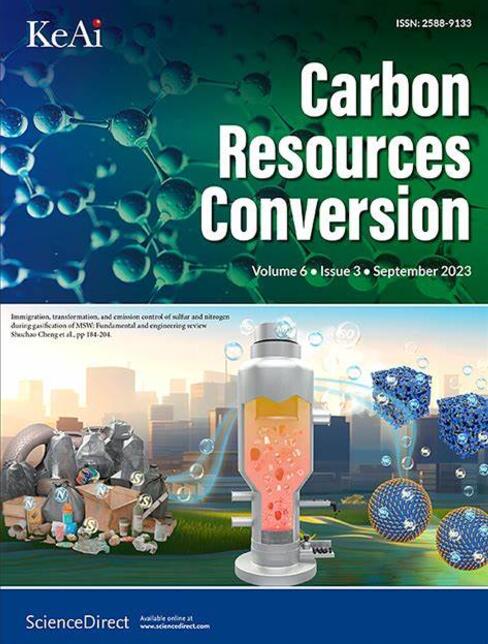The role of graphene Oxide’s aromatic rings in activated carbon made from banana leaves (ACBL) and Fe3O4 in hydrogen production
IF 7.5
3区 环境科学与生态学
Q2 ENERGY & FUELS
引用次数: 0
Abstract
Fe3O4 is an internal magnet that can work as a medium for the electrolyte solution in electrochemical hydrogen production to facilitate electron movement. When Fe3O4 is combined with activated carbon made from banana leaves (ACBL), electron transfer occurs between the ACBL aromatic ring and Fe3+ ions from solved Fe3O4, which increases the solution’s conductivity and finally produces more hydrogen. ACBL is a biomass catalyst used as a free parameter to increase the Fe3O4 magnetic field in the solution. The Fe3O4 was synthesized using the coprecipitation method, while ACBL was obtained through an activation process to produce graphene oxide. Graphene oxide in ACBL was characterized using Scanning Electron Microscopy (SEM) EDX, Fourier Transform Infra-Red (FTIR), Brunauer, Emmett, and Teller (BET), and TEM (Transmission Electron Microscopy). BET was used to determine the surface area of ACBL. Hydrogen was produced using the electrolysis method. The SEM results showed that the elemental content of graphene oxide in ACBL was 72.47 %. The graphene oxide in ACBL had a positive charge represented by a bright color on the sample surface. The positive charge was due to the FTIR O-H and C-O groups working with Fe3O4. BET analysis showed that the average pore diameter of ACBL was 1.68 nm. The largest hydrogen production results were obtained at ACBL 200 mesh, which was 15.5 ml. ACBL from abundant biomass has magnetic and electrical potential within its aromatic ring. As the aromatic ring interacts with the magnetic field of Fe3O4, the electromagnetic field of the solution is strengthened. As a result, hydrogen production increases.

氧化石墨烯的芳香环在香蕉叶活性炭(ACBL)和 Fe3O4 制氢中的作用
Fe3O4是一种内部磁铁,在电化学制氢过程中可以作为电解质溶液的介质,促进电子的运动。当Fe3O4与香蕉叶活性炭(ACBL)结合时,ACBL芳香环与溶解的Fe3O4中的Fe3+离子之间发生电子转移,提高了溶液的电导率,最终产生更多的氢。ACBL是一种生物质催化剂,用作增加溶液中Fe3O4磁场的自由参数。采用共沉淀法合成Fe3O4,采用活化法制备ACBL,制备氧化石墨烯。利用扫描电子显微镜(SEM)、EDX、傅里叶变换红外(FTIR)、布鲁诺尔、埃米特和泰勒(BET)以及透射电子显微镜(TEM)对ACBL中的氧化石墨烯进行了表征。采用BET法测定ACBL的表面积。氢是用电解法制得的。SEM结果表明,ACBL中氧化石墨烯元素含量为72.47%。ACBL中的氧化石墨烯带正电荷,样品表面呈现明亮的颜色。正电荷是由于FTIR O-H和C-O基团与Fe3O4作用。BET分析显示,ACBL的平均孔径为1.68 nm。在ACBL 200目时产氢量最大,为15.5 ml。来自丰富生物质的ACBL在其芳香环内具有磁性和电势。芳香环与Fe3O4磁场相互作用时,溶液的电磁场增强。结果,氢气产量增加。
本文章由计算机程序翻译,如有差异,请以英文原文为准。
求助全文
约1分钟内获得全文
求助全文
来源期刊

Carbon Resources Conversion
Materials Science-Materials Science (miscellaneous)
CiteScore
9.90
自引率
11.70%
发文量
36
审稿时长
10 weeks
期刊介绍:
Carbon Resources Conversion (CRC) publishes fundamental studies and industrial developments regarding relevant technologies aiming for the clean, efficient, value-added, and low-carbon utilization of carbon-containing resources as fuel for energy and as feedstock for materials or chemicals from, for example, fossil fuels, biomass, syngas, CO2, hydrocarbons, and organic wastes via physical, thermal, chemical, biological, and other technical methods. CRC also publishes scientific and engineering studies on resource characterization and pretreatment, carbon material innovation and production, clean technologies related to carbon resource conversion and utilization, and various process-supporting technologies, including on-line or off-line measurement and monitoring, modeling, simulations focused on safe and efficient process operation and control, and process and equipment optimization.
 求助内容:
求助内容: 应助结果提醒方式:
应助结果提醒方式:


